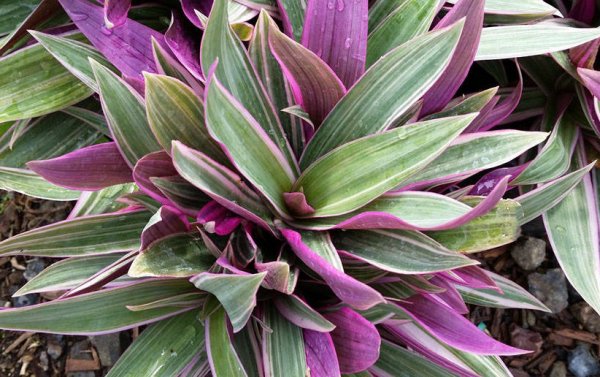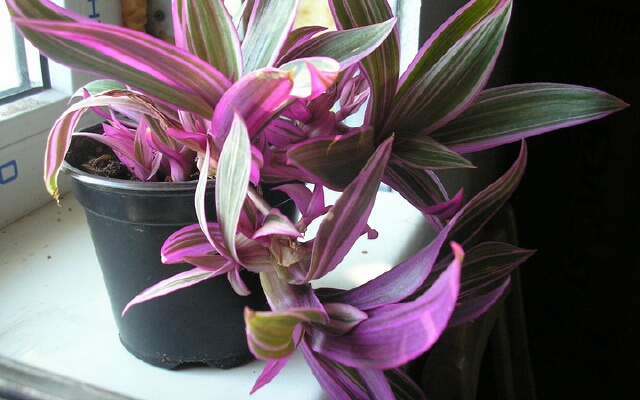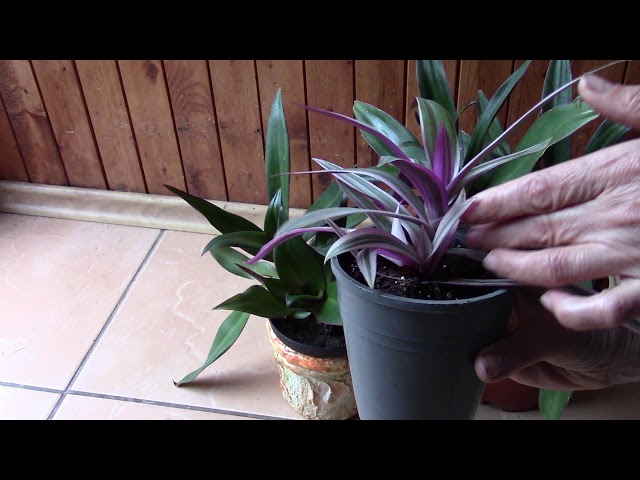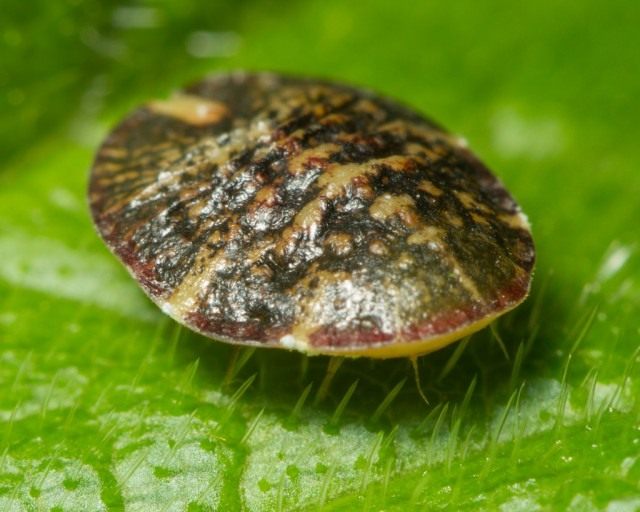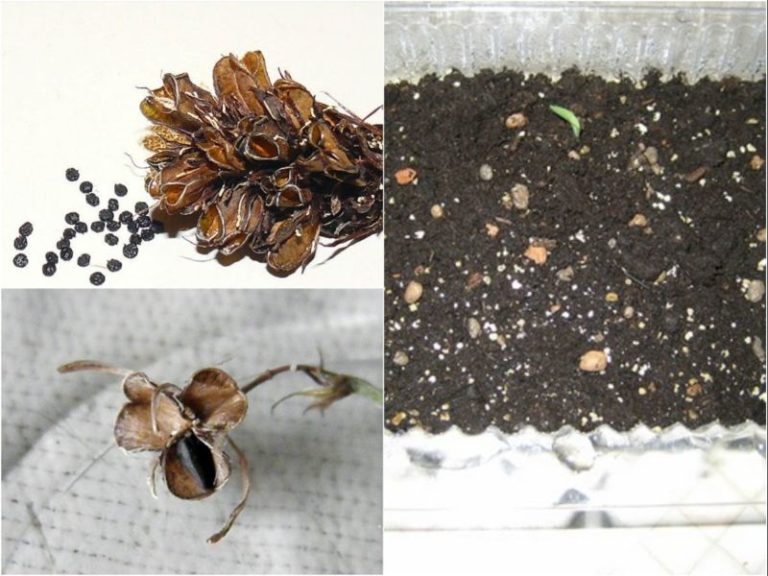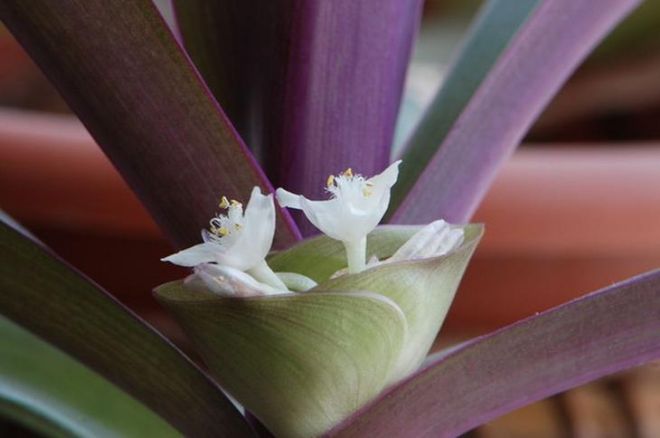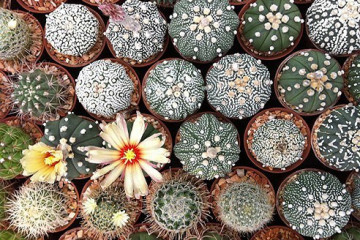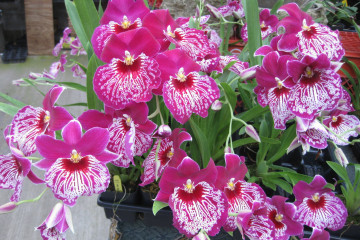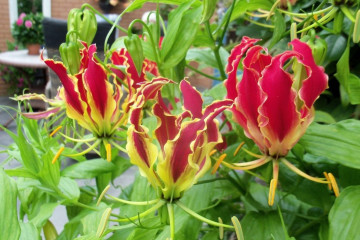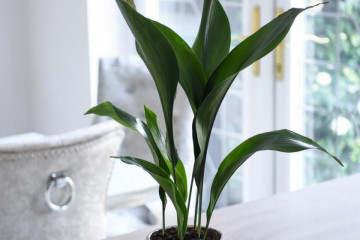Rheo flower: examples of flower care at home
Content:
Reo, or reo, is a flower that has long been known and extremely loved by many flower growers. Some know it by its epic name, the boat of Moses. Most likely, it is associated with the unusual appearance and arrangement of colors. The bracts are usually found at the base of the leaf and resemble boats, which are covered with leaves from above like bedspreads. The habitat of the rheo is the tropical forests of South America and Mexico. In natural conditions, this flower prefers rocky river banks and moist forests, where it chooses well-lit spaces.
Traditionally, the most cultivated among this type of indoor flower is Rheo covered, or, as it is also called, Rheo variegated. It is distinguished by a rich purple color on the back of the leaf. In addition to the well-known rheo variegated, today you can find other varieties.
All about types of reo
Stripe in Pink, unlike its more common cousin Rheo covered, has a pale pink color on the seamy side of the sheet and a pink-white front surface.
Vittata is distinguished by its miniature size and rich purple or bright lilac color on the inside of the leaf. On the outside, there are yellow or cream stripes. Like the previous variety, it is demanding for consecration. In the case of insufficient sunlight, the stripes acquire a pale, poorly expressed shade.
Hawaiian Dworf is loved by flower growers for its peculiar color, consisting of pale green, white and pink stripes evenly distributed over the surface of the leaf.
Spathacea Vittata is sandy on the outside and pink on the seamy side of the rheo. The exotic color of the flower is also extremely sensitive to sunlight, becoming brighter or paler depending on their intensity.
Conditions of detention
Coated Rheo is a rather unpretentious flower and is able to withstand the most Spartan conditions. However, if you do not pay enough attention to it, it will lose its charm and gloss. The plant will feel good at home on a windowsill, where there is a lot of light. Nevertheless, it is still worth shading it from direct rays. The best option would be windows with locations to the east and west. If the sun's rays are not enough for him, the stems of the plant will begin to gradually stretch out and the plant will take on a sloppy appearance.
As a rule, rheo is a flower that is not very picky about the composition of the soil. The usual universal primer from a flower shop or supermarket is quite suitable for him. However, some growers prefer self-prepared earthen substrate. For this, a mixture of sand, peat and turf soil is compiled. Charcoal can be added to prevent root rot.
Rheo care
Rio is an unpretentious flower. A room dweller will feel great at a temperature of 20 ° C in the summer and at least 15 ° C in the winter months. It should be protected from drafts and sudden changes in temperature.
Despite the fact that the rheo flower is able to withstand irregular watering for some time, you should still provide the plant with moisture to the fullest.Moreover, the watering regime directly depends on the season. In summer, this should be done more often, in winter, the amount of watering should be reduced.
The spraying regime also depends on the season. In summer, it is advisable to spray the plant more often, while in winter it is worth reducing the amount of irrigation. It is still not worth it to completely abandon spraying in the winter months, since indoor radiators significantly dry up the air.
All types of rheos that are bred at home are extremely sensitive to water quality. It should be soft, sucking well. Watering with rainwater will also benefit the bright windowsill dweller. But chlorine, which may be in the composition of tap water, will be detrimental to rheo.
To prevent the rheo houseplant from losing its decorative appearance throughout the year, the plant should be fertilized regularly. Starting in early spring, top dressing should be applied every 2-3 weeks. Starting in August, the number of dressings should be reduced, and in winter, completely stopped. There is no need to be afraid that the reo will lack nutrients during the winter months. In the cold season, the plant consumes significantly less nutrients, which contributes to their accumulation in the soil. An oversupply of fertilizer can be detrimental to the flower.
Rheo transplant
Rheo flowers do not need frequent transplantation. It will be enough to replant the plant every few years. Nevertheless, it is necessary to replace the topsoil with a fresh one once a year, since there are practically no nutrients left in it.
Two days before starting the transplant, you should shed the flower well. This is done so that the lump does not crumble when removed from the old pot and thereby does not damage the root system of the rheo. After removing the flower, along with the earthen lump, you should carefully examine the root system for rotted or pest-damaged areas. If any were found, then it is necessary to completely replace the soil.
The new pot for rheo should be 2-3 cm larger than the previous one, but have the same shape. By the way, the choice of the pot is due to the fibrous (growing in breadth) root system. The pot should be large in diameter, but not high.
A drainage layer is necessarily laid out at the bottom of the pot. Expanded clay, ceramic pieces or glass balls, which are sold in specialized stores, can be used as drainage. After the drainage is laid, it is necessary to place a new soil mixture with a layer of at least 1 cm. After that, a root ball with a flower is inserted into the pot and sprinkled with soil.
It is important to take into account that after planting and slight tamping of the soil, the distance to the edge of the pot should be about 3 cm.After the end of the transplant, the plant must be shed well, placed in its usual place and looked after as usual.
Diseases and pests
Usually rheo flowers are not susceptible to disease. However, with poor or improper care, the roots of the flower can rot. In this case, you should dry them and do not pour them in the first few weeks until they are completely cured.
In addition, in exceptional cases, the rheo can attack the scabbard - an extremely dangerous insect that can cause damage, seriously damaging the leaves. Since the insect is reliably protected by a shell, it will not be possible to destroy it simply by spraying it with an insecticide. We'll have to collect the specimens by hand and only then treat them with chemicals.
If the leaves of the rheo have darkened or their tips have dried up, then, most likely, a sharp drop in temperature or drafts have served. In this case, it is necessary to analyze the conditions of detention and eliminate unfavorable factors.
Reproduction of rheo
Over time, an adult rheo plant grows, and even pruning, leaving unattractive hemp, is not able to return its decorative appearance. In this case it is advisable to grow the plant again. There are three ways of reproduction of a rheo flower - by seeds, stem cuttings and side shoots.
If you put the separated process in water, then after 10 days the roots will appear. But you can plant without waiting for the formation of roots. In this case, you should leave the cut cutting for a day so that the cut site dries up. This will prevent the planting material from rotting when it is in the ground. Planting a dried cuttings is very simple: you need to deepen the plant into the soil above the lower bud, lightly tamp the soil, and then water.
Side shoots can be used to obtain planting material. They usually form at the base of the flower if the main stem of the plant is cropped.
Breeding rheo seeds is not practiced, however, it is quite possible. Step by step it looks like this:
- at the beginning of April, the seeds are planted in a box filled with a peat-sand mixture (it is advisable to distribute them evenly over the entire area);
- to create a greenhouse effect, the box is covered with plastic wrap on top;
- crops must be aired and sprayed daily.
Seedlings appear quite quickly and grow without any problems. As soon as they get stronger, young shoots should be planted in separate pots.
The benefits and harms of rheo
Not many people know that rheo leaves can help with some diseases, as they have medicinal properties. Mexicans are known to use rheo leaves to relieve rheumatic pains. Compresses from crushed leaves can stop bleeding, and a decoction is used for intestinal disorders. However, the juice of this plant is considered poisonous and can cause a severe allergic reaction in the form of hives, redness or swelling. It must be remembered that traditional medicine methods also have contraindications, which means that a doctor's consultation is required.
The wonderful rheo flower is perfect for a beginner who wants to try himself as a flower grower. Since reo is a flower, home care is not difficult, you can invite your child to grow a collection of different species. With proper care, the rheo flower at home feels great, which means that this venture is doomed to success.
